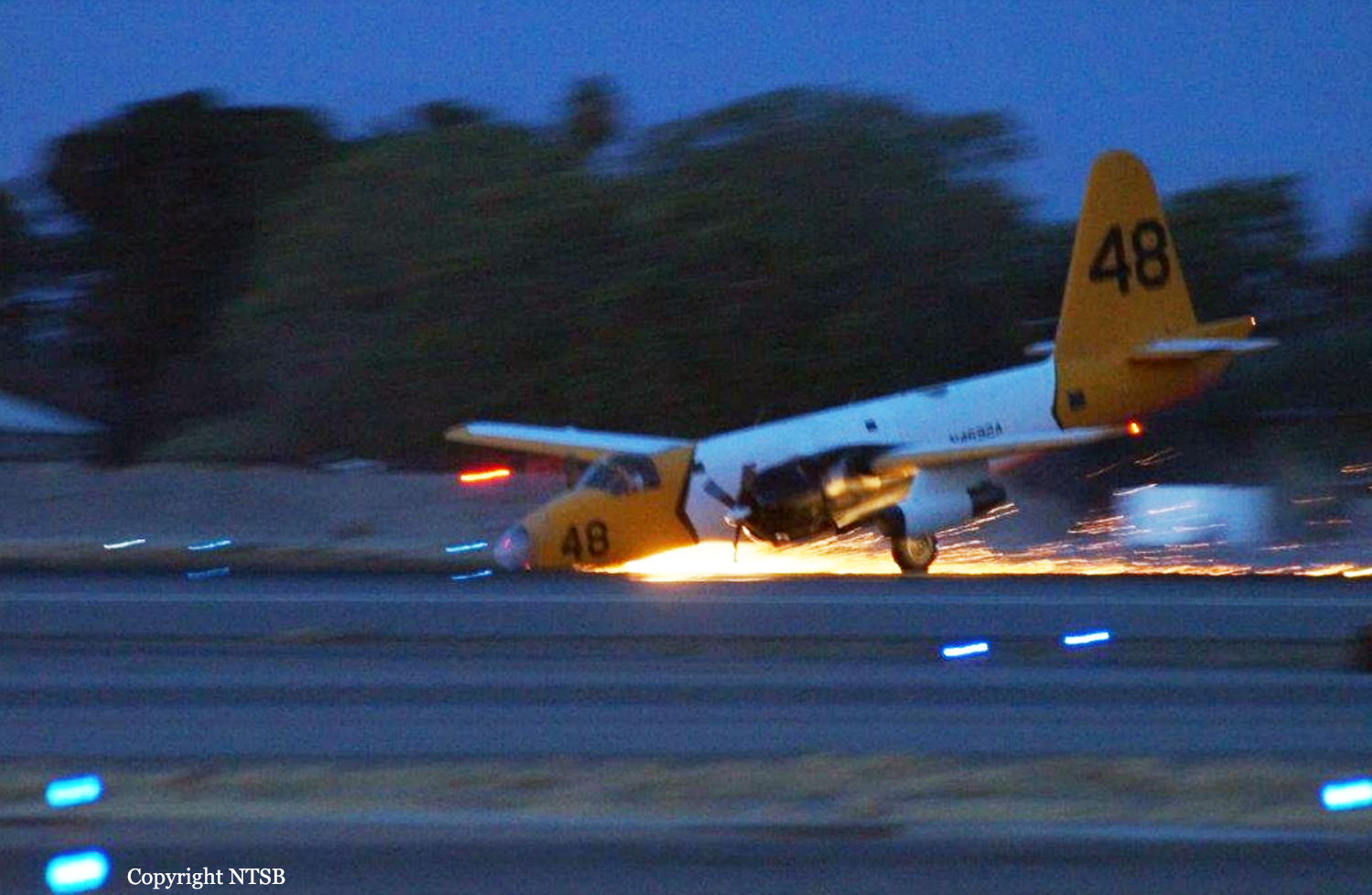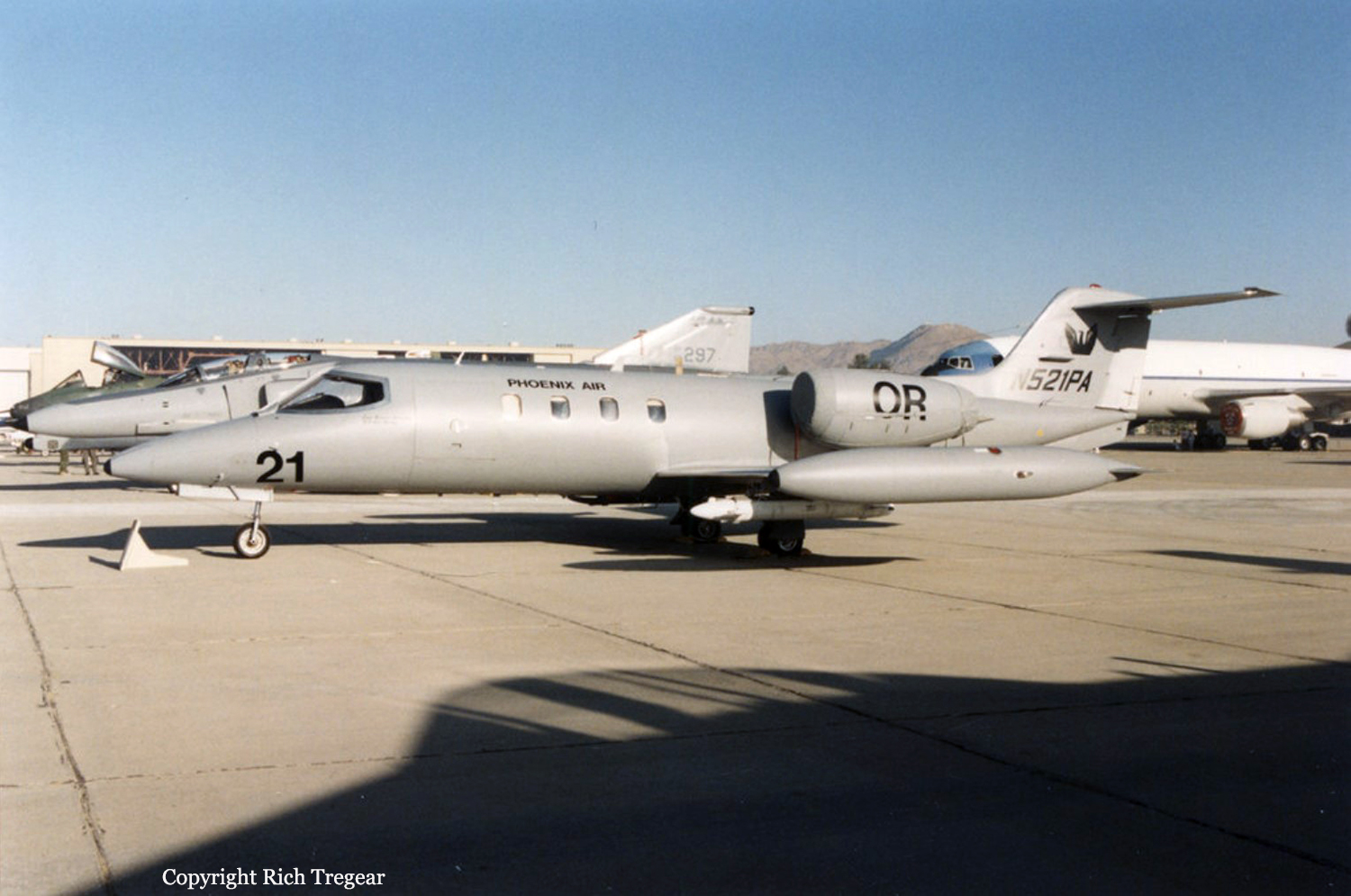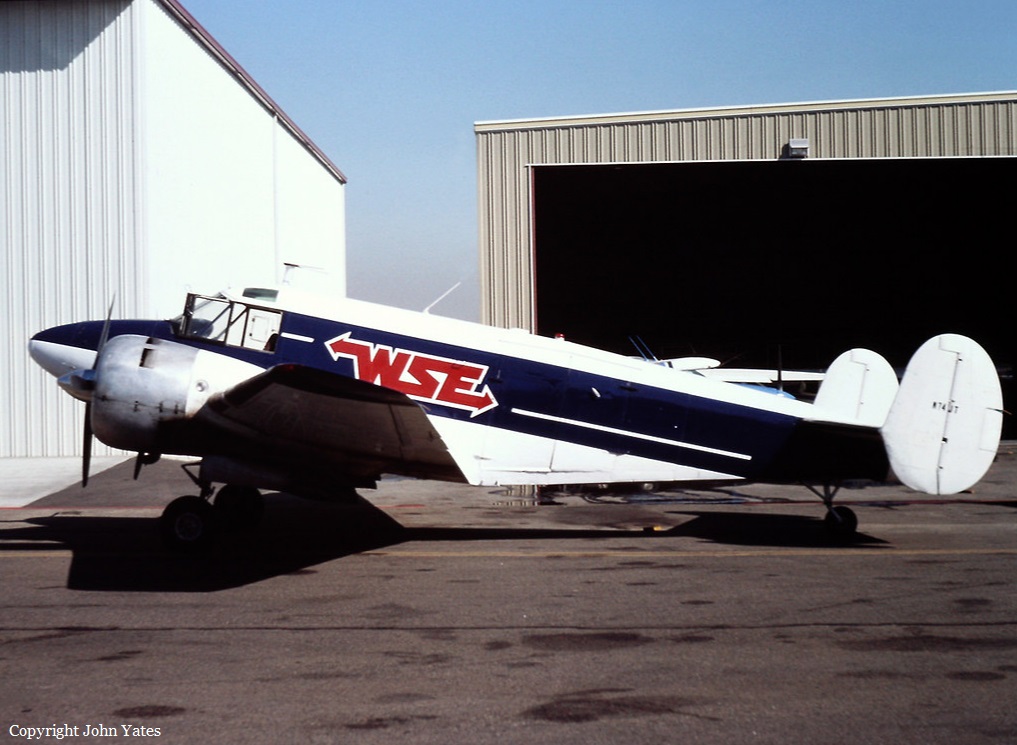Zone
Crash of a Lockheed SP-2H Neptune in Fresno
Date & Time:
Jun 15, 2014 at 2044 LT
Registration:
N4692A
Survivors:
Yes
Schedule:
Porterville - Porterville
MSN:
726-7247
YOM:
1958
Flight number:
Tanker 48
Crew on board:
2
Crew fatalities:
Pax on board:
0
Pax fatalities:
Other fatalities:
Total fatalities:
0
Captain / Total hours on type:
2010.00
Copilot / Total hours on type:
2650
Aircraft flight hours:
10484
Circumstances:
The captain reported that, while returning to the departure airport following an uneventful aerial drop, he noticed that the hydraulic pressure gauge indicated 0. The first officer subsequently verified that the sight gauge for the main hydraulic fluid reservoir was empty. The flight crew began performing the emergency gear extension checklist and verified that the nosewheel landing gear was extended. The captain stated that the first officer then installed the pin in the nosewheel landing gear as part of the emergency checklist. As the flight crewmembers diverted to a nearby airport because it had a longer runway and emergency resources, they briefed the no-flap landing. The first officer extended the main landing gear using the emergency gear release, which resulted in three down-and-locked landing gear indications. Subsequently, the airplane landed normally; however, during the landing roll, the nosewheel landing gear collapsed, and the airplane then came to rest nose low. Postaccident examination of the airplane revealed that the nosewheel landing gear pin was disengaged from the nosewheel jury strut, and the pin was not located. The disengagement of the pin allowed the nosewheel landing gear to collapse on landing. It could not be determined when or how the pin became disengaged from the jury strut. Installation of the pin would have required the first officer to maneuver in a small area and install the pin while the nose landing gear door was open and the gear extended. Further, the pin had a red flag attached to it. When inserted during flight, the flag encounters a high amount of airflow that causes it to vibrate; this could have resulted in the pin becoming disengaged after it was installed. Evidence of a hydraulic fluid leak was observed around the right engine cowling drain. The right engine hydraulic pump case was found cracked, and the backup ring was partially extruded, which is consistent with hydraulic system overpressurization. The reason for the overpressurization of the hydraulic system could not be determined during postaccident examination.
Probable cause:
The collapse of the nosewheel landing gear due to the disengagement of the nosewheel landing gear pin. Contributing to the accident was the failure of the main hydraulic system due to overpressurization for reasons that could not be determined during postaccident examination of the airplane.
Final Report:


Crash of a Learjet 35A in Fresno: 4 killed
Date & Time:
Dec 14, 1994 at 1146 LT
Registration:
N521PA
Survivors:
No
Schedule:
Fresno - Fresno
MSN:
35-239
YOM:
1979
Crew on board:
2
Crew fatalities:
Pax on board:
0
Pax fatalities:
Other fatalities:
Total fatalities:
4
Captain / Total hours on type:
2747.00
Aircraft flight hours:
6673
Aircraft flight cycles:
5254
Circumstances:
At about 1146 pst, Learjet 35A, N521PA, operating as a public use aircraft, crashed in Fresno, CA. Operating with call sign Dart 21, the flightcrew had declared an emergency inbound to Fresno Air Terminal due to engine fire indications. They flew the airplane toward a right base for their requested runway, but the airplane continued past the airport. The flightcrew was heard on tower frequency attempting to diagnose the emergency conditions and control the airplane until it crashed, with landing gear down, on an avenue in fresno. Both pilots were fatally injured. Twenty-one persons on the ground were injured, and 12 apartment units in 2 buildings were destroyed or substantially damaged by impact or fire. Investigation revealed that special mission wiring was not installed properly, leading to a lack of overload current protection. The in-flight fire most likely originated with a short of the special mission power supply wires in an area unprotected by current limiters. The fire resulted in false engine fire warning indications to the pilots that led them to a shutdown of the left engine. An intense fire burned through the aft engine support beam, damaging the airplane structure and systems in the aft fuselage and may have precluded a successful emergency landing.
Probable cause:
The accident was the consequence of the following factors:
- Improperly installed electrical wiring for special mission operations that led to an in-flight fire that caused airplane systems and structural damage and subsequent airplane control difficulties,
- Improper maintenance and inspection procedures followed by the operator,
- Inadequate oversight and approval of the maintenance and inspection practice by the operator in the installation of the special mission systems.
- Improperly installed electrical wiring for special mission operations that led to an in-flight fire that caused airplane systems and structural damage and subsequent airplane control difficulties,
- Improper maintenance and inspection procedures followed by the operator,
- Inadequate oversight and approval of the maintenance and inspection practice by the operator in the installation of the special mission systems.
Final Report:


Crash of a Cessna 414 Chancellor in Taft: 1 killed
Date & Time:
Jul 19, 1994 at 1420 LT
Registration:
N414RH
Survivors:
Yes
Schedule:
Taft - Fresno
MSN:
414-0457
YOM:
1974
Crew on board:
3
Crew fatalities:
Pax on board:
1
Pax fatalities:
Other fatalities:
Total fatalities:
1
Aircraft flight hours:
3739
Circumstances:
The emergency medical service (EMS/medevac) flight was dispatched to transport a patient in response to a medical emergency. During arrival to the destination, the pilot contacted the airport unicom for advisories and was advised to land on runway 25. Runway 25 had a 2.2 percent uphill grade and was restricted to landings only. After landing, the airplane was refueled and the patient was put on board. The pilot back-taxied on runway 25 and proceeded to take off uphill with the airplane near its maximum gross weight. According to ground witnesses, there was a tailwind, which they estimated was between 4 and 15 knots. The temperature was about 100 degrees, and the density altitude was about 3,200 feet. After the airplane became airborne, the pilot started an immediate left turn to avoid rising terrain. However, the left tip tank contacted the ground, and the airplane cartwheeled. It came to rest about 711 feet from the departure end of the runway. The flaps and landing gear were found fully extended; the published configuration for takeoff data in the flight manual was for 'wing flaps - up.' The airport had no signs to indicate runway use restrictions; however, the restrictions were published in the airport facility directory.
Probable cause:
The pilot's inadequate preflight planning/preparation and selection of the wrong runway for takeoff. Factors related to the accident were: the uphill slope of the runway, tailwind, high density altitude, and failure of the pilot to correctly configure the flaps for takeoff.
Final Report:
Crash of a Cessna 208A Cargomaster in Fresno
Date & Time:
Jun 6, 1990 at 1715 LT
Registration:
N803FE
Survivors:
Yes
Schedule:
Fresno - Oakland
MSN:
208-0015
YOM:
1985
Crew on board:
1
Crew fatalities:
Pax on board:
0
Pax fatalities:
Other fatalities:
Total fatalities:
0
Captain / Total hours on type:
335.00
Circumstances:
The engine lost oil pressure while climbing through 6,000 feet, and the pilot requested to return to his departure airport. ATC informed the pilot of a closer airport. The pilot secured the engine, feathered the prop, and made a power-off descent to the airport. The pilot elected to make a downwind approach to runway 12L due to his altitude. The airplane overflew the runway and touched down past the departure end. It penetrated the airport perimeter fence, struck several trees, a sign post, a light pole, and an auto before coming to rest in a residential area. Examination of the wreckage revealed the loss of pressure was due to oil leaking. The oil filler cap was found improperly adjusted after the original installation. The maintenance manual does not approve any field repairs on the oil filler cap engaging mechanisms. The airplane's flaps were found at a 7° intermediate setting.
Probable cause:
A loss of engine oil pressure due to improper maintenance performed on the engine oil filler cap by an unknown person. In addition, the pilot misjudged his landing approach to the runway during the forced landing which resulted in an overshoot and collision with objects. A tailwind contributed to the overshoot.
Final Report:
Crash of a Cessna 340A in Safford: 1 killed
Date & Time:
Feb 14, 1989 at 2245 LT
Registration:
N8814K
Survivors:
No
Schedule:
Fresno – Las Cruces
MSN:
340A-0988
YOM:
1980
Crew on board:
1
Crew fatalities:
Pax on board:
0
Pax fatalities:
Other fatalities:
Total fatalities:
1
Circumstances:
During the night cross country flight at FL250, the pilot elected to leave the cockpit area and move to the rear of the aircraft to attend to physiological needs. Although oxygen was available in the cockpit, supplemental oxygen was not available in the rear. The aircraft was operated with a known pressurization system deficiency which limited the airplane to flight to 17,000 feet msl while maintaining a cabin altitude of 10,000 feet. After 2 hours and 10 minutes, atc declared the flight to be 'no radio'. At 3 hours and 57 minutes after departure, the airplane was plotted on radar in a descending left turn to ground impact. Fuel starvation resulted in power loss to the left engine. Propeller signatures indicated power on the right propeller at impact. The pilot's body was found in the aft cabin area on the aft cabin bulkhead.
Probable cause:
The pilot's poor judgement and the resultant hypoxia sustained in the unpressurized airplane. Factors were: the malfunctioning pressurization system and the pilot's decision to continue operation with that known discrepancy.
Occurrence #1: miscellaneous/other
Phase of operation: cruise - normal
Findings
1. (f) air cond/heating/pressurization - failure, partial
2. (f) operation with known deficiencies in equipment - performed - pilot in command
3. (c) judgment - poor - pilot in command
4. (c) physical impairment (anoxia/hypoxia) - pilot in command
----------
Occurrence #2: loss of engine power (partial) - nonmechanical
Phase of operation: cruise - normal
Findings
5. 1 engine
6. Fluid, fuel - starvation
----------
Occurrence #3: in flight collision with terrain/water
Phase of operation: descent
Occurrence #1: miscellaneous/other
Phase of operation: cruise - normal
Findings
1. (f) air cond/heating/pressurization - failure, partial
2. (f) operation with known deficiencies in equipment - performed - pilot in command
3. (c) judgment - poor - pilot in command
4. (c) physical impairment (anoxia/hypoxia) - pilot in command
----------
Occurrence #2: loss of engine power (partial) - nonmechanical
Phase of operation: cruise - normal
Findings
5. 1 engine
6. Fluid, fuel - starvation
----------
Occurrence #3: in flight collision with terrain/water
Phase of operation: descent
Final Report:
Crash of a Beechcraft H18 in Fresno
Date & Time:
Jun 18, 1982 at 1856 LT
Registration:
N74JT
Survivors:
Yes
Schedule:
Fresno - Los Angeles
MSN:
BA-639
YOM:
1963
Crew on board:
1
Crew fatalities:
Pax on board:
0
Pax fatalities:
Other fatalities:
Total fatalities:
0
Captain / Total hours on type:
2475.00
Aircraft flight hours:
6988
Circumstances:
Just after liftoff from runway 29R, the aircraft began to pitch up. As the pitch up progressed, the pilot applied right aileron and full right rudder. The aircraft responded by rolling to the right with the nose falling thru. Subsequently, the pilot was able to pull out before the aircraft hit the ground. It collided with a 6 feet wire fence which tore off the engines and caused the aircraft to rotate clockwise on the ground. Cargo in the aircraft was thrown thru the side of the fuselage. The pilot exited the aircraft without injury. The aircraft immediately burst into flames and the fuselage was badly burned. An investigation revealed that 2,989 lbs of freight plus a 359 lb motorcycle were being carried between bulkheads 5 & 11. The bulkhead loads were limited to 450 lbs (5-8) and 300 lbs (8-10). The max gross weight at takeoff was estimated to be 10,310 lbs. The pilot reported that none of the freight was tied down.
Probable cause:
Occurrence #1: loss of control - in flight
Phase of operation: takeoff - initial climb
Findings
1. (f) aircraft weight and balance - exceeded - pilot in command
2. (c) tie down - not performed - pilot in command
3. Aircraft handling - not possible
----------
Occurrence #2: in flight collision with object
Phase of operation: takeoff
Findings
4. (f) object - fence
Phase of operation: takeoff - initial climb
Findings
1. (f) aircraft weight and balance - exceeded - pilot in command
2. (c) tie down - not performed - pilot in command
3. Aircraft handling - not possible
----------
Occurrence #2: in flight collision with object
Phase of operation: takeoff
Findings
4. (f) object - fence
Final Report:

Crash of a Rockwell Aero Commander 685 in Ashland: 1 killed
Date & Time:
Dec 12, 1980 at 1845 LT
Registration:
N9221N
Survivors:
Yes
Schedule:
Ashland - Fresno
MSN:
685-12033
YOM:
1973
Crew on board:
1
Crew fatalities:
Pax on board:
4
Pax fatalities:
Other fatalities:
Total fatalities:
1
Circumstances:
After takeoff from Ashland-Parker Airport, the twin engine airplane encountered difficulties to maintain a positive rate of climb and crashed on a hill. The pilot was killed while four other occupants were injured.
Probable cause:
Controlled collision with ground during initial climb after the pilot failed to establish a positive rate of climb. The following contributing factors were reported:
- Low ceiling,
- Fog,
- Visibility 1/4 mile or less.
- Low ceiling,
- Fog,
- Visibility 1/4 mile or less.
Final Report:
Crash of a Cessna 411 in Fresno
Date & Time:
Apr 28, 1978 at 1236 LT
Registration:
N3236R
Survivors:
Yes
Schedule:
Fresno - Sacramento
MSN:
411-0236
YOM:
1966
Crew on board:
1
Crew fatalities:
Pax on board:
5
Pax fatalities:
Other fatalities:
Total fatalities:
0
Captain / Total hours on type:
69.00
Circumstances:
After liftoff, the right engine lost power. The airplane encountered difficulties to gain height, struck tree tops and crashed near the runway end. All six occupants were injured, four of them seriously. The aircraft was destroyed.
Probable cause:
Engine malfunction during initial climb due to inadequate maintenance and inspection. The following contributing factors were reported:
- Fuel systems: pumps,
- Improper alignment/adjustment,
- Excessive pressure,
- Failed to follow approved procedures,
- Failed to use all available runway,
- Improper emergency procedures,
- Fuel filter 30% obstructed,
- High obstructions,
- Right pump over 60 PSI while specificities call for 33,
- Takeoff from midfield (9,281 feet runway),
- Engine not feathered.
- Fuel systems: pumps,
- Improper alignment/adjustment,
- Excessive pressure,
- Failed to follow approved procedures,
- Failed to use all available runway,
- Improper emergency procedures,
- Fuel filter 30% obstructed,
- High obstructions,
- Right pump over 60 PSI while specificities call for 33,
- Takeoff from midfield (9,281 feet runway),
- Engine not feathered.
Final Report:
Crash of a Piper PA-31-310 Navajo in Oakland: 1 killed
Date & Time:
Mar 12, 1977 at 0508 LT
Registration:
N6616L
Survivors:
No
Schedule:
Fresno - Oakland
MSN:
31-549
YOM:
1969
Crew on board:
1
Crew fatalities:
Pax on board:
0
Pax fatalities:
Other fatalities:
Total fatalities:
1
Circumstances:
On final approach to Oakland Airport by night, the left engine failed. The pilot lost control of the airplane that lost height, hit wires/poles and crashed short of runway. The pilot, sole on board, was killed.
Probable cause:
Engine failure on final approach after the pilot attempted operation with known deficiencies in equipment. The following contributing factors were reported:
- Mismanagement of fuel,
- Fuel starvation,
- High obstructions,
- Left engine boost pump written up as inoperative,
- Left fuel gage showed 1/2, right showed empty, crossfeed ON.
- Mismanagement of fuel,
- Fuel starvation,
- High obstructions,
- Left engine boost pump written up as inoperative,
- Left fuel gage showed 1/2, right showed empty, crossfeed ON.
Final Report:



